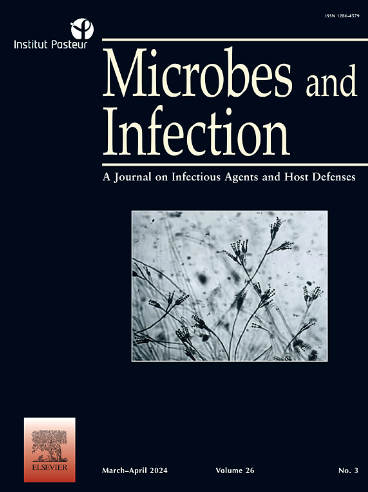铜绿假单胞菌衍生的DnaJ通过tlr10介导的巨噬细胞PI3K-SGK1通路激活诱导TLR2表达。
IF 2.7
4区 医学
Q3 IMMUNOLOGY
引用次数: 0
摘要
TLR2是先天免疫系统的关键组成部分,负责识别革兰氏阳性细菌成分并启动炎症信号级联反应,激活防御反应。然而,关于铜绿假单胞菌对TLR2表达的调控作用,目前所知甚少。在这项研究中,我们研究了P. aeruginosa衍生的DnaJ与巨噬细胞中TLR2表达之间的潜在联系,以及下游信号通路的激活。我们的研究结果显示,DnaJ以剂量和时间依赖的方式显著诱导TLR2表达,主要影响TLR2,对其他tlr(如检测细菌PAMPs的TLR4和TLR5)的影响最小。dnaj介导的TLR2诱导是由PI3K-SGK1信号通路的激活驱动的,TLR10在促进这些作用中起着至关重要的作用。TLR2表达的增加导致继发性金黄色葡萄球菌感染时炎症细胞因子的产生增加,表明其在增强宿主防御机制中起作用。综上所述,这些发现表明P. aeruginosa来源的DnaJ通过tlr10介导的PI3K-SGK1通路激活促进TLR2表达,从而增强宿主对革兰氏阳性细菌感染的免疫应答。本文章由计算机程序翻译,如有差异,请以英文原文为准。
Pseudomonas aeruginosa-derived DnaJ induces TLR2 expression through TLR10-mediated activation of the PI3K-SGK1 pathway in macrophages
TLR2 is a key component of the innate immune system, responsible for recognizing Gram-positive bacterial components and initiating inflammatory signaling cascades that activate defense responses. However, little is known about the regulatory effects of Pseudomonas aeruginosa (P. aeruginosa) on TLR2 expression. In this study, we investigated the potential link between P. aeruginosa-derived DnaJ and TLR2 expression in macrophages, as well as the activation of downstream signaling pathways. Our findings revealed that DnaJ significantly induced TLR2 expression in a dose- and time-dependent manner, predominantly affecting TLR2 with minimal impact on other TLRs, such as TLR4 and TLR5, which detect bacterial PAMPs. The DnaJ-mediated TLR2 induction was driven by activation of the PI3K-SGK1 signaling pathway, with TLR10 playing a crucial role in facilitating these effects. This increase in TLR2 expression led to enhanced production of inflammatory cytokines in response to secondary Staphylococcus aureus infections, indicating a role in boosting host defense mechanisms. In conclusion, these findings suggest that P. aeruginosa-derived DnaJ promotes TLR2 expression via TLR10-mediated activation of the PI3K-SGK1 pathway, thereby enhancing host immune responses against Gram-positive bacterial infections.
求助全文
通过发布文献求助,成功后即可免费获取论文全文。
去求助
来源期刊

Microbes and Infection
医学-病毒学
CiteScore
12.60
自引率
1.70%
发文量
90
审稿时长
40 days
期刊介绍:
Microbes and Infection publishes 10 peer-reviewed issues per year in all fields of infection and immunity, covering the different levels of host-microbe interactions, and in particular:
the molecular biology and cell biology of the crosstalk between hosts (human and model organisms) and microbes (viruses, bacteria, parasites and fungi), including molecular virulence and evasion mechanisms.
the immune response to infection, including pathogenesis and host susceptibility.
emerging human infectious diseases.
systems immunology.
molecular epidemiology/genetics of host pathogen interactions.
microbiota and host "interactions".
vaccine development, including novel strategies and adjuvants.
Clinical studies, accounts of clinical trials and biomarker studies in infectious diseases are within the scope of the journal.
Microbes and Infection publishes articles on human pathogens or pathogens of model systems. However, articles on other microbes can be published if they contribute to our understanding of basic mechanisms of host-pathogen interactions. Purely descriptive and preliminary studies are discouraged.
 求助内容:
求助内容: 应助结果提醒方式:
应助结果提醒方式:


